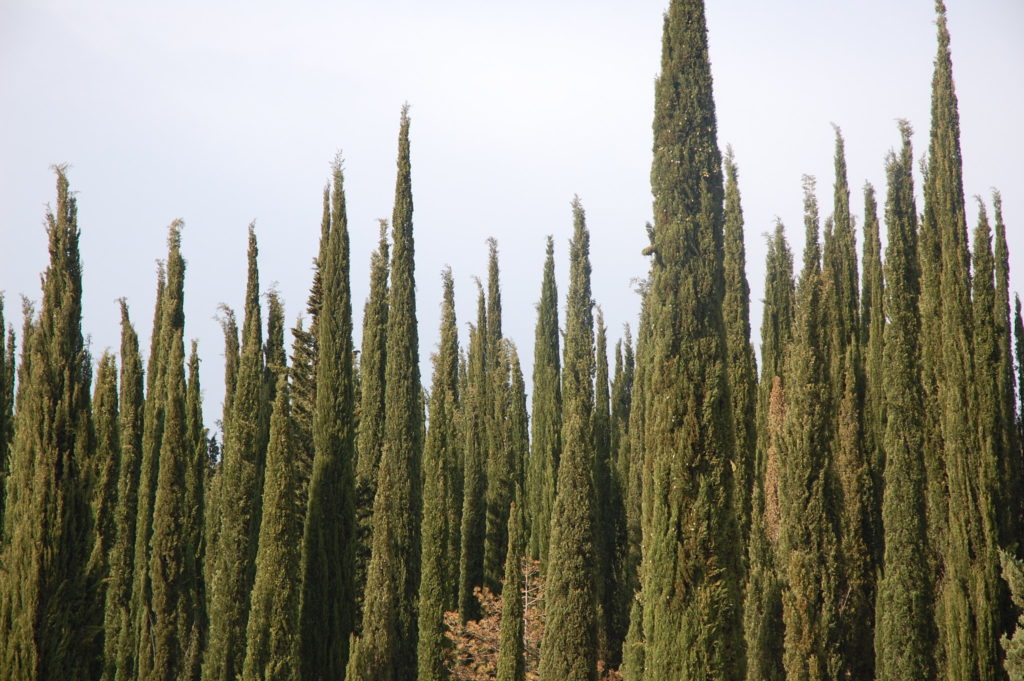- About Us
- Our Work
- Tree Info
- Get Involved
- Blog
- Support Us
By Canopy Team on January 20, 2020

Italian cypress photo by Mad Kramers via Flickr
Tree Spotlight Series: Follow along as we learn about the fascinating trees that live among us. This series is in partnership with Rhee Lab in the Plant Biology Department of the Carnegie Institution for Science.
Other posts in the series: ginkgo biloba, Douglas fir, giant sequoia, Chinese tallow, silver-dollar gum, Monterey pine, green dracaena, coast live oak, cork oak, Japanese maple, silver birch, dawn redwood, Japanese persimmon ‘Hachiya’, carob, California bay, avocado, southern magnolia, flowering dogwood, red ironbark eucalyptus, blackwood acacia, narrow leaved paperbark, cockspur coral, Chinese pistache, California pepper tree, and toyon.
Imagine walking up to a grand mansion in rural Italy. The long, unpaved driveway is lined with formidable towers of green trees. Rising up every few feet or so, the trees act as sentinels of the mansion. With the crunch of gravel beneath your feet, you smell the tree’s mild scent of pine. Your eyes squint from the sunlight as you look upward to see the tip of the trees.
Reaching up to 115 feet, the impressive columned figures guide you towards the mansion. Amongst the small shrubbery and the endless lush green hills, Italian cypress trees are a sight to behold. Luckily, rural Italy isn’t the only place that the species resides.
The Italian cypress (Cupressus sempervirens) originally comes from Persia and the Mediterranean region. It can be found all throughout eastern Europe and in many southwestern states in America. It thrives in arid climates with plenty of sunlight and can withstand drought.
The species can grow in an array of different soils such as sand, clay, and many types of acidic soils. With this, the Italian cypress is ideal as an ornamental tree and is prized for its medicinal properties and its wood in many countries.
While the tree can be found in gardens or pressed up next to homes and buildings, the tree is also found in much darker settings. In Turkey, the tree is known for being the “cemetery tree” and found in cemeteries across the country. The tree is also deeply embedded in Roman, Iranian, and Greek mythology as a symbol of mourning. For example, one poem written by the Roman poet Ovid tells of a boy named Cyparissus who accidentally killed his pet stag while hunting at night. Overwhelmed with grief, the boy eventually transformed into the Cupressus sempervirens where the sap of the tree represents his tears.
Surprisingly, the Italian cypress tree can also be found on the shelves of drug stores. The species’ shoots and leaves produce an essential oil that is often incorporated into soaps, perfumes, deodorants, and anti-dandruff shampoos. The main active components of the oil are α-pinene and δ-3-carene.
These secondary metabolites are highly valued for their immunological properties. For instance, the tree’s oil is a popular component in natural deodorants because of its antibacterial properties. Along with preventing the cultivation of bacterial colonies, the oil’s slightly clean and spicy fragrance prevents body odor.
Secondly, the oil is reported to prevent symptoms of anxiety. When adding a few drops to a diffuser, users have reduced restlessness during sleep and felt relaxed. Lastly, when used topically, the oil helps increase blood flow, treats varicose veins, and deters muscle cramping. With its many functional and ornamental properties, the Italian cypress is a truly versatile tree.
Suhyun (Suzie) Lee is a 2019 summer intern at the Rhee Lab in the Plant Biology Department of the Carnegie Institution for Science. She is a first year student at Cal Poly University studying biology. Molecular biology has always piqued her interest and in the future, she hopes to pursue research regarding the defense mechanisms of organisms and phenotypic plasticity within plants or animals. In her free time she loves to paint, hike, and garden.